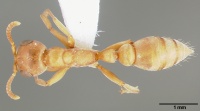Pseudomyrmex janzeni
| Pseudomyrmex janzeni | |
|---|---|

| |
| Scientific classification | |
| Kingdom: | Animalia |
| Phylum: | Arthropoda |
| Class: | Insecta |
| Order: | Hymenoptera |
| Family: | Formicidae |
| Subfamily: | Pseudomyrmecinae |
| Genus: | Pseudomyrmex |
| Species group: | ferrugineus |
| Species: | P. janzeni |
| Binomial name | |
| Pseudomyrmex janzeni Ward, 1993 | |
Colonies occupy Acacia hindsii and are polygynous; additional details of the life history can be found in Janzen's (1973) paper on polygynous acacia-ants.
Identification
Ward (1993) - Within the P. ferrugineus group P. janzeni can be characterized by its relatively small size (worker and queen HW < 1 .04), broad head (worker CI > 0.86), laterally rounded median clypeal lobe, and uniform orange-brown color. P. janzeni is evidently closely related to Pseudomyrmex ferrugineus (as surmised by Janzen 1973); all of the metric measurements and indices of these two species overlap, although there is a tendency for P. janzeni workers to have shorter, higher petioles. Workers and queens of P. janzeni are perhaps best distinguished from those of P. ferrugineus by the combination of lighter orange-brown color, suberect gular pubescence (best seen in a backlit lateral view of the head), and the flatter profile of the worker mesosoma (see description above). While some individuals of the highly variable P. ferrugineus approach these conditions there is no indication of a convergence towards this morphology in western Mexico (Guerrero) where populations of P. ferrugineus come closest to those of P. janzeni.
Distribution
Western Mexico
Latitudinal Distribution Pattern
Latitudinal Range: 23.3167° to 20.614°.
| North Temperate |
North Subtropical |
Tropical | South Subtropical |
South Temperate |
- Source: AntMaps
Distribution based on Regional Taxon Lists
Neotropical Region: Mexico (type locality).
Distribution based on AntMaps
Distribution based on AntWeb specimens
Check data from AntWeb
Countries Occupied
| Number of countries occupied by this species based on AntWiki Regional Taxon Lists. In general, fewer countries occupied indicates a narrower range, while more countries indicates a more widespread species. |

|
Estimated Abundance
| Relative abundance based on number of AntMaps records per species (this species within the purple bar). Fewer records (to the left) indicates a less abundant/encountered species while more records (to the right) indicates more abundant/encountered species. |

|
Biology
Castes
Nomenclature
The following information is derived from Barry Bolton's Online Catalogue of the Ants of the World.
- janzeni. Pseudomyrmex janzeni Ward, 1993: 143, figs. 19, 29, 64, 70 (w.q.m.) MEXICO.
Unless otherwise noted the text for the remainder of this section is reported from the publication that includes the original description.
Description
Worker
Worker measurements (n = 12). —HL 1.00-1.18, HW 0.93-1.03, MFC 0.063-0.096, CI 0.88-0.94, REL 0.4S-0.47, REL2 0.49-0.S2, OOI 1.45-2.29, VI 0.58-0.68, FCI 0.068-0.098, SI 0.42-0.4S, SI2 0.84-0.91, NI 0.62-0.69, PLI 0.59-0.71, PWI 0.63-0.73, PPWI 1.37-1.73.
Very similar to P. ferrugineus (q.v.) except as follows. Size smaller, on average. In lateral view mesonotum less steeply inclined; basal and declivitous faces of Propodeum forming a less obtuse angle. Petiole shorter and higher, on average. Weak rugulo-punctate sculpture on Propodeum even less evident than in P. ferrugineus. Pubescence denser, becoming decumbent to suberect on parts of body, most notably the gula. Head and mesosoma rather light orange-brown, gaster the same or a slightly darker brown.
Type Material
Holotype worker. MEXICO, Nayarit: 60 mi. SE Acaponeta, Hwy. I5, l5.ix.1963, D. H. Janzen (Los Angeles County Museum of Natural History). HW 1.00, HL 1.08, EL O.51, PL O.55, PH 0.36.
Paratypes. Same data as holotype: series of 1 66 workers, 62 queens and 45 males (American Museum of Natural History, The Natural History Museum, California Academy of Sciences, Estacion de Biologia Chamela, Graham B. Fairchild Museo de Invertebrados, Instituto Nacional de Biodiversidad, LACM, Museum of Comparative Zoology, Museu de Zoologia da Universidade de Sao Paulo, Philip S. Ward Collection, University of California, Davis, National Museum of Natural History).
References
- Ward, P. S. 1993. Systematic studies on Pseudomyrmex acacia-ants (Hymenoptera: Formicidae: Pseudomyrmecinae). J. Hym. Res. 2: 117-168 (page 143, figs. 19, 29, 64, 70 worker described)
- Ward, P.S. 2017. A review of the Pseudomyrmex ferrugineus and Pseudomyrmex goeldii species groups: acacia-ants and relatives (Hymenoptera: Formicidae). Zootaxa 4227: 524–542 (doi: 10.11646/zootaxa.4227.4.3).
References based on Global Ant Biodiversity Informatics
- Brandao C. R. F., F. A. Esteves, and L. P. Prado. 2010. A catalogue of the Pseudomyrmecinae ant type specimens (Hymenoptera, Formicidae) deposited in the Museu de Zoologia da Universidade de Sao paulo, Brazil. Papeis Avulsos de Zoologia 50(45): 693-699.
- Dattilo W. et al. 2019. MEXICO ANTS: incidence and abundance along the Nearctic-Neotropical interface. Ecology https://doi.org/10.1002/ecy.2944
- Vasquez-Bolanos M. 2011. Checklist of the ants (Hymenoptera: Formicidae) from Mexico. Dugesiana 18(1): 95-133.
- Vásquez-Bolaños M. 2011. Lista de especies de hormigas (Hymenoptera: Formicidae) para México. Dugesiana 18: 95-133
- Ward, P.S. 1993. Systematic studies on Pseudomyrmex acacia-ants (Hymenoptera: Formicidae) Journal of Hymenoptera Research 2(1):117-168

